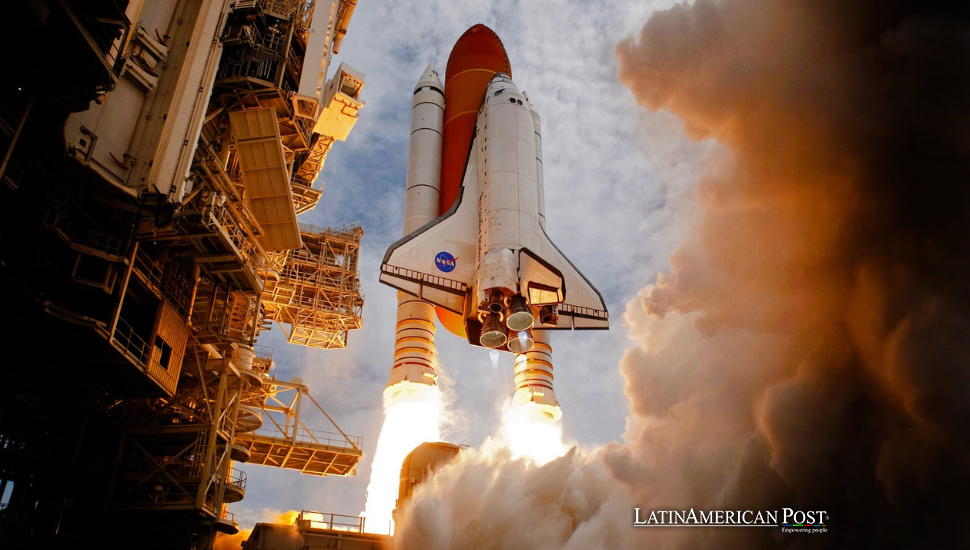Mexican Engineer’s Biomaterials Project Heads to Space, Making History

Victoria de León, a 21-year-old Mexican engineer, has created a biomaterial for lunar habitats that will soon be tested on the International Space Station (ISS). Her pioneering research showcases Mexico’s potential in space innovation and sustainable construction.
Mexican Engineer Develops Revolutionary Lunar Biomaterial
In an unprecedented achievement, Victoria de León, a 21-year-old Mexican engineer, is set to send her innovative biomaterials project to the International Space Station (ISS). Recently honored at the 75th International Astronautical Congress (IAC) in Milan, Italy, de León’s research blends lunar soil, or regolith, with insect-derived biopolymers. The result is a highly adaptable material designed to protect future lunar habitats from micrometeorites and radiation exposure.
In an interview with Wired, de León explained her goals: “The biomaterial I developed aims to shield habitats on the Moon from micrometeorites that travel up to 70 km/s, as there’s no atmosphere to buffer them.” She notes that these tiny projectiles pose significant risks, potentially damaging the structural integrity of lunar colonies. Her groundbreaking material, a combination of lunar regolith and sustainable biopolymers sourced from insects, addresses this critical challenge.
This dual-purpose solution also has the potential to meet the protein needs of astronauts on long-term missions, as the insects involved in producing the material could be sustainably farmed on the Moon. De León’s work is a testament to Mexico’s growing role in the space sector and a forward-thinking approach to sustainable lunar colonization.
The Economics of In-Situ Resource Utilization on the Moon
De León’s research is grounded in In-Situ Resource Utilization (ISRU), which emphasizes using available resources to minimize reliance on Earth. This highly efficient and economically advantageous approach has the potential to redefine space exploration. “The economic feasibility of transporting resources to the Moon is limited. By developing a biomaterial from regolith and biopolymers, we can construct lunar habitats without constant supply missions,” she told Wired.
According to de León, the lunar regolith can be extracted and combined with biopolymers sourced from mealworms, silkworms, and other high-protein insects studied as sustainable food options for astronauts. Her process involves shipping insects only once to the Moon, then using controlled reproduction protocols to support a closed-cycle protein source and material production.
This innovative approach could substantially reduce the high costs associated with lunar missions. By producing materials directly on the Moon, space agencies can minimize cargo loads, extending the reach of space exploration. “This aligns with a circular economy model, where every resource is repurposed. It’s a shift from dependency to self-sufficiency,” de León explains. Her model can potentially lower space travel’s financial and logistical burden, fostering sustainable extraterrestrial economies.
Overcoming Technical Challenges in Space Innovation
De León’s journey has not been without significant obstacles. Combining robotics and biology, two fields that rarely intersect, required de León to step beyond her initial expertise as a robotics and digital systems student. “I had to learn experimental chemistry from scratch,” she shared with Wired. Her learning curve was steep, balancing long hours in the lab with university studies.
Much of her research involved trial and error, testing biopolymers for flexibility, durability, and radiation sensitivity. One discovery, a unique fluorescence property in the biopolymer, was groundbreaking and had not been documented in scientific literature. “The fluorescence feature was unexpected. It could potentially serve as a passive radiation sensor, making it invaluable for space habitats,” she explained.
Her biomaterial protects against lunar radiation and could be used as a wall tapestry within habitats. The material’s flexibility allows for multiple applications, from strengthening habitats against micrometeorites to serving as a radiation warning system. This multi-functionality is essential for maximizing the efficiency of lunar habitats. As de León stated, “Creating biomaterials that adapt to extreme conditions opens new possibilities in space and beyond.”
The International Astronautical Congress recognized the originality of her work, awarding her the Best Interactive Presentation in the Space and Society category among 1,200 global participants. De León hopes her research will inspire others in Mexico and Latin America to pursue careers in space technology despite limited local resources.
Paving the Way for Mexico’s Space Sector
De León’s success marks a new chapter for Mexico in space exploration. As she told Wired, representing her country internationally is an honor and a responsibility. “We have come a long way in advancing Mexico’s presence in space science,” she said. “It’s time for Mexico to embrace its potential in this emerging field, and I call on the government to support our contributions.”
Mexico’s limited space budget has historically restricted the country’s role in global space exploration. However, de León’s work demonstrates the impact of innovative research, even with limited resources. With the proper governmental support, Mexico could establish a more significant role in the space sector, fostering a new generation of engineers and scientists equipped to meet the challenges of lunar and planetary exploration.
Her call to action is clear: Mexico’s future in space is within reach if the country invests in education, research, and technology. De León’s work with biomaterials opens doors for sustainable space exploration and highlights the potential for similar applications here on Earth, aligning with the UN’s Sustainable Development Goals. “If we can make this technology work on the Moon, imagine what we could do on Earth to build a more sustainable infrastructure,” she said.
Also read: Chile Pioneers Region’s First 3D Printed ‘Seed House’
As her project prepares to launch to the ISS, de León envisions a future where Mexican scientists contribute actively to global space exploration, creating technologies that benefit both Earth and extraterrestrial habitats. Her accomplishments set a precedent for Mexico’s innovation on the world stage, inspiring future generations to pursue science and engineering.





